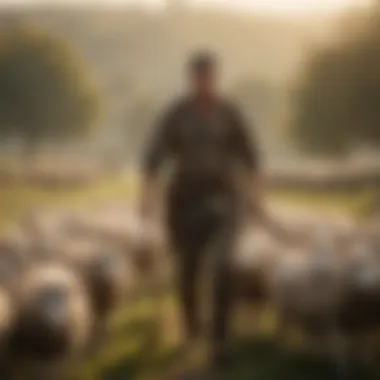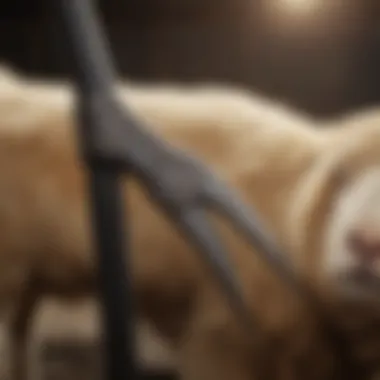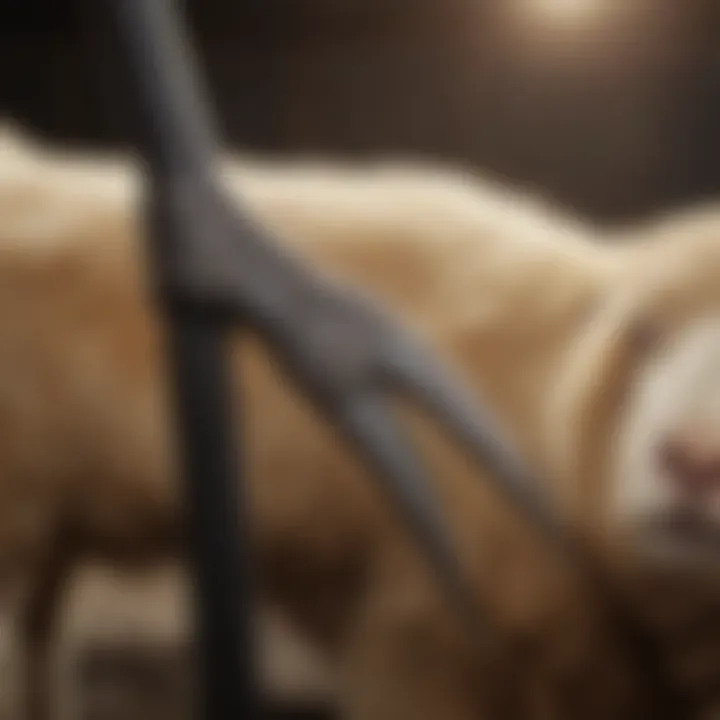The Shepherd's Crook for Sheep: A Comprehensive Analysis


Overview of the Topic
Definition and Importance
The shepherd's crook is more than just a tool; it embodies the practices and traditions of sheep management through the ages. Traditionally, it functions as both an aid for handling sheep and a symbol of the shepherd's role. The crook’s design allows for effective herding and guidance, making it an essential item in any shepherd’s toolkit. Its significance extends beyond its practical use, as it reflects the cultural heritage of pastoral communities worldwide. For those involved in sheep farming, understanding the crook’s functionality and place within modern practices can enhance the management of flocks.
Current Trends
Today, there is renewed interest in traditional farming methods, including the use of tools like the shepherd's crook. Innovations have led to variations in design that cater to specific agricultural needs. Some modern shepherds are also incorporating smart technologies alongside traditional tools, thus blending the old with the new. This dual approach encourages effective sheep management while respecting the historical relevance of such implements.
Key Techniques and Practices
Step-by-Step Guide
The effectiveness of the shepherd's crook lies in its versatility. Here is a brief guide to its usage:
- Observation: Learn to understand sheep behavior. This knowledge is key to effective herding.
- Approach: Use the crook to guide sheep without startling them. A gentle movement is often more effective than force.
- Control: Utilize the hooked end of the crook to safely redirect animals. It allows for a safe distance, preventing stress.
- Joining the Flock: When integrating a new sheep, use the crook to help guide it towards the group without causing disruption.
Tools and Equipment Needed
In addition to a shepherd's crook, a few other tools can enhance your sheep management:
- Whistle: Useful for signaling to dogs or for long-distance communication.
- Fencing tools: Ensure secure areas for your sheep to roam.
- Tags: For identification purposes to manage flock members easily.
Challenges and Solutions
Common Obstacles
Shepherding comes with its own set of challenges. These can include:
- Predator threats: Livestock guardian dogs can be essential, as they protect sheep from natural predators.
- Health Issues: Regularly monitor sheep for signs of distress or illness, as early detection is crucial.
- Weather Conditions: Adverse weather can affect both sheep health and pasture availability.
Innovative Solutions
To address these challenges, several strategies can be implemented:
- Education: Increase knowledge of sheep behavior through courses and workshops.
- Technology: Use trackers or GPS devices to monitor sheep locations and movement patterns.
- Integrated Grazing: Implement rotational grazing practices to preserve pasture quality and animal health.
"A well-used shepherd's crook can enhance the relationship between shepherd and flock, fostering trust and efficient management."
These approaches can help shepherds navigate issues while providing care for their flocks, aligning tradition with modern agricultural methods.
Understanding the Shepherd's Crook
The shepherd's crook serves as more than just a tool; it embodies the essence of sheep management throughout history. Understanding it requires acknowledging its multifaceted roles and significance. The crook is pivotal in facilitating daily tasks on a farm. With its unique design, it aids in herding sheep, ensuring a harmonious interaction between the shepherd and their flock. This tool serves as an extension of the shepherd's body, fostering a connection that is both practical and symbolic.
Proper comprehension of the crook can enhance its utility and maximize effectiveness in sheep management strategies. By grasping the history, cultural nuances, and various functionalities of the crook, farmers can gain insights into how this instrument has evolved and continue its relevance today. The practical benefits of using a crook include ease of handling, safety for both sheep and shepherds, and its ergonomic advantages.
Educational opportunities abound when exploring this tool, as it can inspire new methods of sheep management that align with modern practices while respecting traditions.
Historical Context
The shepherd's crook has roots that trace back thousands of years. Its historical narrative reveals its evolution alongside sheep farming itself. Ancient civilizations, such as the Egyptians and the Greeks, utilized similar tools in sheep herding. Initially designed from wood, the materials have varied by region and culture, adapting to the environments in which the shepherds worked.
Documents and artifacts shed light on how the crook became an integral part of pastoral life. The craftsmanship surrounding the crook has also evolved, reflecting advances in woodworking and metallurgy. The simple yet ingenious design of the crook speaks to its enduring functionality through the ages. Moreover, the crook has appeared in literature and religious texts, signifying its broader significance in cultural traditions.
Cultural Significance


The shepherd's crook carries deep cultural meanings. In various societies, it symbolizes shepherding as a noble profession. Beyond practicality, it represents stewardship and care for livestock. Artists and writers have often depicted the crook as a sign of protection and guidance.
In many cultures, the crook is embraced in folklore and myth, often embodying themes of leadership and dedication. Festivals celebrating farming and sheep herding frequently highlight this tool. The crook reflects the interconnectedness of humans and animals, emphasizing respect for the land and resources.
"The crook is not just a tool; it is a symbol of the bond between shepherd and flock, cultivated over time through tradition and care."
Understanding these cultural contexts enhances farmers' appreciation and promotes the preservation of these practices. Recognizing the shepherd's crook as a cultural artifact, communities can maintain traditions that enrich agricultural practices.
Design and Functionality
The design and functionality of the shepherd's crook are central to its effectiveness in sheep management. The crook is not just a tool; it embodies the blend of tradition and practicality required for working with sheep. Understanding its design elements can lead to better practices while minimizing stress for both shepherds and sheep.
Materials Used
The materials that comprise the shepherd's crook deeply influence its durability and usability. Most commonly, wood is the primary material, chosen for its availability and structural integrity. Different types of wood, such as oak or hickory, provide various levels of strength and flexibility.
However, some modern variations might use aluminum or fiberglass. These materials can reduce the weight of the crook while maintaining sufficient strength, allowing for easier handling during long hours of herding. Selecting the right material is crucial, as it impacts both the longevity of the crook and the effort required to use it proficiently.
Ergonomic Considerations
The ergonomic design of the shepherd's crook plays a significant role in enhancing the efficiency of the shepherd. The handle's shape must provide a comfortable grip without causing strain during extended use. Research shows that crooks designed with a slight curve can improve leverage when directing sheep, while padded grips can prevent blisters and discomfort.
A well-designed crook allows the shepherd to maintain a relaxed posture. This is essential when working long hours in the field, as maximizing comfort can reduce fatigue significantly. A lack of ergonomic consideration may lead to physical issues for the user, ultimately affecting productivity and the well-being of the sheep.
Length and Shape Variations
The length and shape of the shepherd's crook vary based on regional practices and the specific needs of the herding environment. Generally, crooks range from five to seven feet, but the ideal length can differ depending on the shepherd's height and the terrain. A longer crook provides increased reach, which can be helpful in wide-open spaces where sheep tend to spread out. Conversely, a shorter crook may offer greater control in more confined areas.
Shape variations include traditional curved crooks and modern straighter designs. Each shape serves a purpose; the curve is often used for catching and guiding sheep, while straighter designs may facilitate pushing or prodding, especially in crowded conditions.
Role in Sheep Management
The shepherd's crook plays a pivotal role in sheep management, serving as an indispensable tool for the effective handling and oversight of sheep herds. Its design stems from both practical needs and historical significance, enabling shepherds to navigate various challenges encountered in the daily management of these animals. This section highlights three primary aspects of the crook's contribution to sheep management: herding techniques, injury prevention, and training young sheep.
Herding Techniques
The shepherd's crook is integral to various herding techniques used by shepherds to guide and control their flocks. By using the crook, a shepherd can apply gentle pressure to redirect a sheep's movement without causing distress. This facilitates a smooth flow during herding, especially in crowded or complicated environments. The hook at the end of the crook can be useful for catching a sheep by the leg or neck, providing a quick means to assist or reposition an individual sheep when needed.
This tool also allows for the stewardship of the flock in different terrains, from steep hills to flat pastures. Employing the crook effectively often requires skill and experience, yet it remains an accessible instrument for shepherds of all levels. Through an understanding of herd dynamics and sheep behavior, the crook enhances a shepherd's ability to manage effectively—and efficiently—while ensuring the well-being of the animals.
Injury Prevention
Injuries to sheep can occur frequently without meticulous management. The shepherd's crook contributes to preventing these accidents in a few significant ways. First, it allows the shepherd to maintain a safe distance while managing the flock. This is especially helpful in situations where sheep are skittish or agitated. By keeping a certain distance, the shepherd can avoid startling the flock and triggering chaotic movements that could lead to injuries.
Furthermore, the crook aids in limiting physical contact with the sheep. By providing guidance without direct handling, there’s less chance of trampling or other injuries during management tasks. Also, trained shepherds employ the crook to assist sheep carefully, minimizing the risk of harm during any necessary interventions, such as assisting with birthing or separating animals.
Training Young Sheep
Training young sheep is a critical component of sheep management, and the shepherd's crook serves as a valuable tool in this process. Young sheep, or lambs, require guidance to develop essential skills that ensure they thrive within the flock. The crook can help gently guide them towards desired behaviors, helping lambs to learn about movement within the group and understanding commands from the shepherd.
By utilizing the crook in training sessions, shepherds can create a structured environment where lambs can practice and hone their skills. This engagement fosters a sense of belonging within the flock while enhancing their responsiveness to the shepherd's commands. As these lambs grow, the foundational training established with the crook leads to a more manageable and cohesive flock that readily responds to shepherding cues in the future.
Regional Variations
Regional variations of the shepherd's crook present a vivid illustration of how local cultures and environments shape agricultural tools. This section delves into the specifics of design, function, and usage in different parts of the world. Understanding these variations is essential for shepherds and farmers as they consider which design may best suit their specific needs and circumstances. Moreover, the regional adaptations reflect the cultural significance of the crook in various societies, showcasing its importance beyond mere functionality.
European Designs
In Europe, the design of the shepherd's crook has evolved through centuries of tradition and necessity. Typically, European crooks feature a longer shaft, usually made from sturdy hardwood. This construction offers durability, ensuring that it withstands the rigors of daily use in rugged landscapes. The curves at the top, while distinct in each country, share a common purpose: to aid in guiding sheep without harming them.


For instance, the Welsh crook is notably characterized by its sharp curve, facilitating precise movements during herding. In contrast, the Scandinavian crook combines a broader grip with an elongated shaft to allow the shepherd to maintain control over larger flocks. These designs reflect regional herding practices that prioritize the safety and efficiency of both the animals and the shepherd.
North American Adaptations
North American adaptations of the shepherd's crook reveal both practicality and the influence of indigenous design. The wide-open spaces suitable for grazing require tools that are efficient over large areas. North American crooks often have a more utilitarian approach, made from lighter materials like fiberglass or aluminum. This shift allows for easier handling and maneuverability across vast territories.
Additionally, adaptations incorporate unique features such as a straightened shaft, which some shepherds prefer for flexibility in tight spaces. The diversity of terrain has also led to variations where some crooks include additional tools, such as integrated carabiners or multi-functional ends, enabling shepherds to carry out multiple tasks without needing to switch instruments.
Asian Methods
In Asia, the approaches to shepherding and the tools used also vary significantly. Traditional Asian crooks often serve a multi-faceted purpose, integrating functionality that stretches beyond herding alone. Many of these shepherd's crooks are lightweight, reflecting the need for mobility in diverse environments, from high grasslands to rocky terrains.
For example, in regions such as Tibet, shepherds use modified crooks that can also act as walking sticks for traversing steep slopes. The designs may include intricate markings that signify cultural heritage, turning the crook into a symbol of identity. Furthermore, some variations in the Middle East incorporate decorative elements, blending aesthetics with functionality while paying homage to historical legacy.
The shepherd's crook is not just a tool; it embodies the essence of sheep management strategies across the globe.
In sum, regional variations of the shepherd's crook offer deep insights. Understanding these distinctions allows sheep farmers to appreciate the role of design in enhancing productivity and animal welfare. By adopting or adapting these variations, modern shepherds can uphold traditions while meeting contemporary agricultural demands.
Economic Impact
The economic impact of the shepherd's crook in sheep management extends beyond its primary function of herding. Understanding this economic aspect is crucial for those involved in agriculture, especially farmers who rely heavily on sheep for their livelihoods. The shepherd’s crook represents not just a tool but rather a cornerstone of efficient sheep management and productivity.
Efficient herding and management practices encourage higher yields, reduce the incidence of injury, and ultimately enhance the financial viability of sheep farming.
"Investing in traditional tools like the shepherd's crook can lead to significant long-term gains in sheep husbandry."
Cost-Benefit Analysis
In assessing the economic impact of the shepherd's crook, a cost-benefit analysis reveals a clear picture of its value. While there is an initial investment in acquiring a quality crook, the benefits often outweigh these costs.
- Cost considerations:
- Benefit aspects:
- Material Quality: A durable shepherd's crook may cost more upfront but saves money over time due to lower replacement rates.
- Maintenance Needs: Regular upkeep is required to ensure its longevity, which involves minimal costs if done correctly.
- Increased Efficiency: The proper use of the crook allows shepherds to manage larger flocks more effectively, which can expand their operations without significantly increasing costs.
- Reduced Labor Costs: With improved herding techniques, farmers may require fewer hands on deck, leading to overall reductions in labor costs.
Evaluating these factors provides sheep farmers with a clearer understanding of how investing in the right tools enhances economic outcomes.
Long-term Investment
When considering the shepherd's crook as a long-term investment, it important to see beyond the initial purchase. This tool embodies the essence of sustainable farming practices. Investing in a sturdy shepherd's crook ensures reliability for many years.
- Durability: A well-built crook, crafted from quality materials, serves effectively across multiple seasons. This longevity translates into cost savings in the long run.
- Increased Production: Consistent and competent management of sheep herds leads to enhanced wool and meat production. Farmers tapping into these benefits create a more sustainable economic model for their operations.
- Heritage and Tradition: Using a traditional tool like the shepherd's crook also honors farming heritage. For many farmers, this connection to the past enhances their own sense of identity and purpose.
Sustainability Aspects
Sustainability plays an essential role in sheep management practices, particularly regarding the use of the shepherd's crook. This tool not only aids shepherds in managing their flocks but also contributes to more sustainable agricultural practices. Evaluating the environmental and economic factors involved in the use of a shepherd's crook becomes increasingly critical as the industry looks to minimize its ecological footprint.
Resource Efficiency
Resource efficiency in sheep farming is vital. Utilizing resources wisely ensures that inputs align with outputs, promoting sustainability. The shepherd's crook, made from natural materials like wood or metal, can be produced with minimal resource expenditure compared to synthetic alternatives.
Regions with abundant timber can sustainably source materials for these tools, reducing reliance on plastic or other non-biodegradable materials. Additionally, the longevity of a well-crafted shepherd's crook means that it doesn’t need frequent replacements, which further contributes to resource efficiency.
- Durability: High-quality wooden crooks can last for years with proper care.
- Sourcing: Locally sourced materials ensure lower transportation emissions.
- Repairability: Simple repairs can extend the life of the crook, reducing waste.
Environmental Benefits


The environmental benefits of the crook extend beyond its materials. By promoting humane herding techniques, the shepherd's crook plays a critical role in conserving animal welfare. When sheep are handled gently, stress levels decrease, leading to less aggressive behaviors and lower incidence of injury or disease within the flock.
Moreover, effective herding reduces the need for chemical methods to manage sheep movement, thus minimizing chemical runoff into local ecosystems. A sustainable practice not only focuses on the immediate benefits for farmers but also considers the broader ecological impacts.
"Sustainable herding practices supported by tools like the shepherd's crook can lead to healthier sheep and ecosystems together."
Innovations in Shepherding
Innovations in shepherding represent a critical shift in modern agriculture. As practices evolve, new tools and techniques emerge. These changes improve efficiency, enhance animal welfare, and promote sustainable farming. With increasing pressures from population growth and climate change, adapting innovations becomes necessary for effective sheep management.
Technological Advances
Technological advances provide numerous benefits to shepherds. The integration of drones in livestock monitoring improves the ability to check on sheep across vast terrains. Drones allow for real-time data collection and herding performance monitoring. Through aerial views, shepherds can assess flock health and movements more effectively than traditional methods.
In addition, livestock tracking devices have become increasingly popular. GPS-enabled collars provide valuable information about sheep location. This reduces the risks of getting lost and enables better planning during grazing or market movements.
Moreover, mobile applications for flock management have emerged. These apps simplify record keeping, allowing farmers to log health checks, breeding schedules, and feeding routines. This digital approach promotes better decision-making and more streamlined operations. Therefore, embracing these technologies is essential for modern sheep farming.
Integration with Modern Agriculture
Integrating innovations with modern agriculture streamlines processes and enhances productivity. One significant aspect of this integration is the collaboration between technology providers and farmers. By employing cutting-edge solutions, farmers can maximize their resources and minimize waste. With more data-driven decision-making, they can optimize feed usage or irrigation schedules based on specific environmental conditions.
Furthermore, the practice of rotational grazing benefits from technological integration. Using software to forecast pasture growth encourages better land management. This promotes not only animal health but also the sustainability of the land.
The climatic changes demand that farmers rethink traditional methods. Innovations play a crucial role in meeting these challenges. The successful combination of new techniques and age-old knowledge creates a resilient agricultural practice.
"Innovation in shepherding is not just about new tools, but a complete mindset shift to embrace change for better results."
Safety Considerations
Ensuring safety in shepherding is a crucial aspect that should not be overlooked. The use of the shepherd's crook, while primarily a practical tool for managing livestock, also presents several safety considerations that both shepherds and their sheep must regard. Addressing these points can lead to improved efficacy in sheep management and enhanced overall well-being for the animals involved.
Shepherd's Safety
The safety of the shepherd is paramount when dealing with sheep. The shepherd's crook, by design, can be a double-edged sword. It offers benefits in directing and controlling livestock but may also pose risks if not used correctly. Here are some key safety considerations related to the shepherd himself:
- Proper Handling: Training in the correct use of the crook is essential. Untrained individuals may mishandle the tool, leading to accidents.
- Physical Fitness: It is important for shepherds to maintain a level of physical fitness to manage animals effectively. Fatigue can lead to decreased awareness and increase the likelihood of accidents.
- Awareness of Surroundings: Understanding the environment while using a crook is critical. Shepherds must be constantly aware of their surroundings to avoid slipping, tripping, or getting injured while maneuvering the tool.
- Protective Gear: Consideration of wearing appropriate safety gear while managing livestock is vital. This could include sturdy footwear and gloves to prevent injuries during herding tasks.
Animal Welfare Standards
Animal welfare is an important aspect of sheep management and should align with the use of tools like the shepherd's crook. Ensuring that these practices uphold animal welfare standards contributes to the happiness and productivity of the flock. Below are considerations that underscore the link between the use of the crook and the welfare of sheep:
- Gentle Handling: The crook should be used gently, preventing undue stress to the animals. Rough handling can lead to behavioral issues among the sheep.
- Minimizing Stress: The approach of the shepherd directly influences the flock’s welfare. Utilizing the crook to guide sheep should always be carried out with care to minimize stress responses.
- Monitoring Health: Regularly checking the flock while managing them with the crook ensures that no sheep suffers injuries during the herding process. Swift action in case of any observed injury is also critical.
- Training: Shepherds should be trained to understand animal behavior and how to use their crooks in a manner that respects and upholds the welfare of the animal.
Ending
The conclusion of this article serves as a vital component in reinforcing the importance of the shepherd's crook within sheep management and agriculture. Understanding the multifaceted roles and benefits of this tool enables shepherds to enhance their practices while ensuring the welfare of their sheep. Throughout the document, we have explored various aspects, including historical significance, design variations, and modern applications. These elements not only highlight the crook's practicality but also its cultural resonance across different regions.
In summary, the shepherd's crook provides crucial support in herding and managing sheep effectively. It contributes to minimizing injuries during handling and enhances the safety of both the shepherd and the flock. Emphasizing animal welfare standards ensures that ethical practices are upheld in the industry. Moreover, by adopting modern technologies alongside traditional methods, shepherds can create a more efficient system that respects both heritage and innovations.
"The shepherd's crook is not merely a tool; it embodies a legacy of practice that balances respect for tradition while embracing advancements in agriculture."
Summation of Findings
In this analysis, we have discussed several key findings:
- Historical Origins: The shepherd's crook has a rich history that traces back centuries, demonstrating its enduring significance in agricultural practices.
- Design Variations: Different regions have developed unique forms and materials for the crook, enhancing its functionality in diverse environments.
- Modern Applications: The integration of technologies has helped redefine the role of the crook, making it more efficient in contemporary farming scenarios.
- Safety and Welfare: By focusing on safety considerations, the crook not only protects the shepherd but also promotes higher standards for animal welfare.
Future Directions
Looking ahead, several future directions can be envisaged for the shepherd's crook:
- Innovative Design: There is potential for research and development of new materials, possibly incorporating sustainable resources that enhance the crook's durability and usability.
- Smart Technology Integration: Future iterations may include smart technology features such as sensors that monitor sheep activity, further aiding in herd management.
- Educational Resources: Developing training programs that highlight effective techniques in using the shepherd’s crook can empower new shepherds with essential skills.
- Collaboration with Agricultural Sciences: Building partnerships between shepherds and agricultural researchers may lead to better practices that benefit both sheep and their environment.
Ultimately, the shepherd's crook holds a promising future as a key resource in the quest for sustainable and humane sheep management.



